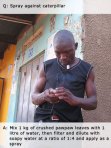 More evidence today that the recession is a truly global phenomenon. While in the developed economies of North America, Europe, Japan and Australasia ARPU has been falling and sales of handsets are in decline, over in the burgeoning markets of Africa, (Egypt, Nigeria, South Africa and Kenya, for example) the mobile industry has continued to roar ahead -until today. Martyn Warwick reports.
More evidence today that the recession is a truly global phenomenon. While in the developed economies of North America, Europe, Japan and Australasia ARPU has been falling and sales of handsets are in decline, over in the burgeoning markets of Africa, (Egypt, Nigeria, South Africa and Kenya, for example) the mobile industry has continued to roar ahead -until today. Martyn Warwick reports.
But today comes news that, for one carrier at least, the economic downturn has now hit home and profitability is on the wane at Safaricom of Kenya, Africa’s biggest mobile carrier.
Mobile penetration in Africa has roared ahead in recent ayears and some industry observers had opined that companies like Safaricom might continue to grow despite the recession. It seems now that this has more to do with wishful thinking than dispassionate analysis.
Figures released this morning show that Safaricom’s full-year profits slid by 23 per cent – mainly because of the prevailing economic conditions but increased competition and increased costs of servicing debt have also played their part.
For the financial year ended 31 March Safaricom made a profit of 15.3 billion Kenyan Shillings – that’s about £126 million Sterling. For the previous year ended march 31, 2008, the company made 19.9 billion Shillings in profit.
Perhaps more worrying is that although the operator’s total revenues were up 15 per cent year on year, ARPU (globally accepted as being a major indicator of performance) is in serious decline have fallen by a massive 23 per cent to 475 Shillings a month.
Over the past 12 months Kenya has suffered remarkably high inflation as the national currency has weakened and the costs of basic foodstuffs, fuel and transport have rocketed. Kenyan consumers, the vast majority of whom are far from wealthy, have less disposable discretionary income than they did 12 months ago and they are using their phones less.
Confidence was also severely dented by the ethnic violence that followed the results of the disputed 2008 general election and that has had a long-term effect on the economy.
Safaricom has been one of Africa’s great success stories. It is the biggest company in East Africa, is valued at in excess of £1 billion, has 2,300 employees and 13 million subscribers. The company is 40 per cent owned by Vodafone, 25 per cent by both private and institutional investors and 35 per cent owned by the Kenyan state.
It has a market share of 79 per cent and has increased its customer base by 31 per cent over the course of 18 months.
However, the market is changing and Safaricom faces increased competition from a raft of rivals including Essar telecom’s “Yu”, Zain of Kuwait and the Orange network of the incumbent, Telkom Kenya. As a result of this intense competition mobile tariffs have fallen by 40 per cent in just a year.
 Commenting on the results, Safaricom’s CEO, the amiable and approachable Michael Joseph said, “It was probably our most challenging year in terms of operating environment. But it’s not all gloom, we have delivered strong results despite the difficult economic conditions and there has been strong growth in the popular M-Pesa money transfer services, with 6.2 million registered users now compared to the 2.1 million of the previous year.”
Commenting on the results, Safaricom’s CEO, the amiable and approachable Michael Joseph said, “It was probably our most challenging year in terms of operating environment. But it’s not all gloom, we have delivered strong results despite the difficult economic conditions and there has been strong growth in the popular M-Pesa money transfer services, with 6.2 million registered users now compared to the 2.1 million of the previous year.”
The CEO added that Safaricom will continue to invest in its network and will also look to acquisitions to maintain its strategy for consistent growth. Mr. Joseph said, “Our capital expenditure is expected to remain high over the next few years as we continue the roll out of our data infrastructure and continue to invest in the capacity, coverage and quality of our network.”
Meanwhile, Richard Hurst, a senior telecoms analyst at research house IDC commented, “In the past, Safaricom has been quite a solid operator, usually coming up with some decent numbers, so it is a bit of a surprise,” and added that Safaricom will have to spend big money on enhancing and expanding its infrastructure if it is to fend off competition and maintain its Number One position.
Hurst believes though that the overall African telecoms will continue to grow at rates higher than in other markets. He says, “We’ve still got some quite substantial growth to go, it’s [the African market] not as saturated as the European, North American or even Asian markets. I think this is just a blip.”
Let’s hope so. New figures from Nigeria expected to be published in the coming weeks may show whether this is indeed a “blip” confined to one company in one country or if the malaise is spreading across Africa.







